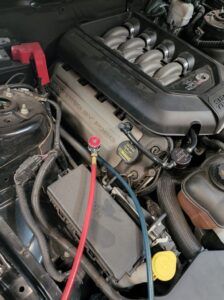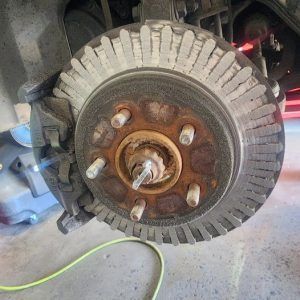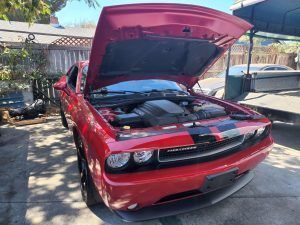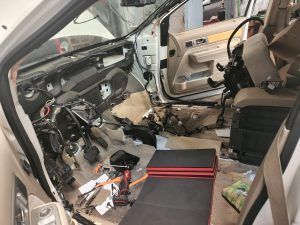Car AC Condenser Issues: Common Problems And Fixes
Are you experiencing issues with your car’s AC condenser? Don’t worry, we’ve got you covered.
In this article, we will discuss common problems that can occur with your car’s AC condenser and provide you with the necessary fixes to get your AC system back up and running smoothly.
One common problem you may encounter is leaking refrigerant. This can be caused by worn-out seals or damaged hoses. Luckily, this issue can be easily fixed by replacing the faulty components and recharging the system with the correct amount of refrigerant.
Another issue that can arise is clogged condenser fins. This can happen due to dirt, debris, or even small insects getting trapped in the fins. Cleaning the fins with a soft brush or compressed air can help restore proper airflow and cooling efficiency.
Fan motor failure is yet another common problem. This can be caused by a faulty motor or a malfunctioning relay switch. Replacing the motor or the switch can usually solve this issue.
A damaged condenser, whether it be due to a collision or corrosion, can also lead to AC problems. In such cases, replacing the condenser is the best solution.
Lastly, electrical issues such as faulty wiring or a malfunctioning control module can cause AC condenser problems. Identifying and repairing the electrical issue will restore proper functionality.
By understanding these common problems and their fixes, you can save time and money by addressing the issues promptly. So, let’s dive into each problem and learn how to fix them!
Key Takeaways
– Leaking refrigerant, clogged condenser fins, fan motor failure, and damaged condenser are common problems with car’s AC condenser.
– Promptly addressing these issues is important to save time and money.
– Regular cleaning and maintenance of condenser fins is crucial to prevent clogs and maintain efficient cooling.
– Identifying and repairing electrical issues is essential for the smooth operation of the AC system.
Leaking Refrigerant: Causes and Solutions
Are you tired of dealing with a car AC that constantly leaks refrigerant? We’ve got the solutions you need to fix this frustrating problem once and for all!
When your car’s AC system is leaking refrigerant, it not only leads to poor cooling performance but can also cause damage to the environment. To fix this issue, the first step is refrigerant leak detection. This involves using specialized tools to identify the source of the leak, which can be anywhere from the hoses and connections to the evaporator or condenser.
Once the leak is detected, the next step is refrigerant leak repair. Depending on the severity of the leak, it may involve replacing faulty components, such as O-rings or seals, or repairing damaged sections of the AC system. It is crucial to address refrigerant leaks promptly to prevent further damage and ensure optimal performance of your car’s AC.
Now, let’s move on to the next section about clogged condenser fins and the causes and solutions to this common problem.
Clogged Condenser Fins: Causes and Solutions
If you’re experiencing issues with your car’s AC system, one common problem could be clogged condenser fins. This can be caused by debris, dirt, or other contaminants that accumulate over time.
To address this, you can clean and maintain the condenser regularly, ensuring that it remains free from any blockages. Additionally, using a fin comb can help straighten any bent fins, allowing for better airflow and optimal performance of your car’s AC system.
Common Causes of Clogged Fins
To prevent clogged fins in your car’s AC condenser, it’s essential that you regularly clean and maintain them. Here are four common causes of clogged fins that you should be aware of:
1. Dirt and debris: Over time, dirt, leaves, and other debris can accumulate on the condenser fins, blocking airflow and reducing the efficiency of your AC system.
2. Insects and bugs: Insects, such as bees and wasps, can build nests or lay eggs in the condenser fins, causing blockages and hindering proper cooling.
3. Road grime and pollution: The condenser fins can also get clogged with road grime and pollution, especially if you frequently drive in dusty or polluted areas.
4. Rust and corrosion: Rust and corrosion can damage the condenser fins, leading to blockages and reduced performance.
Regular cleaning and maintenance can help prevent these issues and ensure optimal performance of your car’s AC system.
In the next section, we’ll discuss effective cleaning methods and prevention techniques to keep your condenser fins in top shape.
Cleaning and Maintaining the Condenser
Keeping your condenser fins clean and well-maintained is crucial for ensuring optimal performance of your car’s air conditioning system. Regular condenser maintenance is essential to prevent the accumulation of dirt, debris, and other contaminants that can clog the fins and restrict airflow.
To clean the condenser, start by disconnecting the power source and removing any protective covers. Use a soft brush or compressed air to gently remove the dirt and debris from the fins. Be careful not to damage the fragile fins while cleaning. Additionally, you can use a mild detergent and water solution to remove stubborn grime. Rinse thoroughly and let it dry completely before reassembling.
By following these condenser cleaning techniques, you can improve the efficiency and lifespan of your car’s AC system.
Now, let’s move on to the next section and learn how to use a fin comb to straighten bent fins.
Using a Fin Comb to Straighten Bent Fins
Straightening bent fins using a fin comb is like combing through tangled hair to restore a smooth and efficient airflow. It’s a crucial step in maintaining the performance of your car’s AC condenser. Here are four reasons why using a fin comb is essential for condenser maintenance:
1. Improved Airflow: Bent fins obstruct the airflow, reducing the condenser’s efficiency. Straightening them with a fin comb ensures consistent and unrestricted airflow, maximizing cooling performance.
2. Prevents Refrigerant Leaks: When fins are bent, they can puncture the refrigerant tubes. Straightening them minimizes the risk of leaks, preventing potential damage and costly repairs.
3. Extends Lifespan: Regularly straightening the fins prevents them from becoming permanently damaged or broken. This prolongs the lifespan of your condenser, saving you from the need for premature replacement.
4. Enhances Efficiency: By restoring the fins to their original position, the condenser can work optimally, improving overall system efficiency and reducing energy consumption.
Regular maintenance, including using a brush for condenser cleaning and straightening bent fins, is crucial for preserving your car’s AC system. Properly maintaining the condenser prepares us for the next section on fan motor failure: causes and solutions.
Fan Motor Failure: Causes and Solutions
Is your car’s fan motor acting up? Don’t worry, we’ve got the scoop on what might be causing the issue and how you can fix it! The fan motor plays a crucial role in keeping your car’s AC system running smoothly by circulating air through the condenser. When the fan motor fails, it can lead to a variety of problems, including reduced cooling efficiency and potential damage to the AC system. To troubleshoot fan motor issues, start by checking the fuses and relays related to the fan motor. If those are in working order, it’s time to consider fan motor replacement. Before replacing the motor, ensure that the wiring connections are secure and free of any corrosion. Once you’ve installed the new fan motor, test it to ensure it’s working properly. Remember, if you’re not confident in your abilities, it’s always best to consult a professional mechanic. Now that we’ve covered fan motor failure, let’s move on to the next section about damaged condenser causes and solutions.
Damaged Condenser: Causes and Solutions
If your car’s fan motor has failed, you now need to address another potential issue with your car’s AC system: a damaged condenser. The condenser is an essential component of the AC system, responsible for cooling the refrigerant and turning it from a gas to a liquid.
A damaged condenser can lead to a variety of problems, including reduced cooling performance and even a complete AC system failure. When dealing with a damaged condenser, you have two options: repair or replacement. In some cases, minor damage can be repaired by a professional using specialized tools and techniques. However, if the damage is extensive or the condenser is severely corroded, replacement may be necessary to ensure optimal performance and longevity of your AC system.
To troubleshoot a damaged condenser, start by inspecting it for physical damage such as bent fins, leaks, or corrosion. If you notice any of these signs, it’s best to consult with a professional technician who can accurately assess the extent of the damage and recommend the appropriate course of action.
Now, let’s move on to the next section where we will discuss electrical issues that can affect your car’s AC system.
Electrical Issues: Causes and Solutions
When it comes to your car’s AC system, one thing you need to watch out for are electrical gremlins that can wreak havoc and leave you sweating in the summer heat. Electrical issues can cause a variety of problems with your car’s AC condenser, but luckily, there are some common causes and solutions.
One common electrical issue is a malfunctioning fan motor. If your condenser’s fan motor stops working, it can lead to poor performance and overheating. In this case, the solution is to replace the fan motor. This can be done by disconnecting the old motor, removing it from the condenser, and installing a new one. It’s important to ensure that the replacement motor is compatible with your specific car model.
Another electrical issue that can arise is a dirty condenser coil. Over time, the condenser coil can become clogged with dirt, debris, and other contaminants. This can obstruct airflow and reduce the efficiency of the AC system. To fix this issue, the condenser coil needs to be cleaned. This can be done by using a coil cleaner and a soft brush to remove any dirt or debris. It’s important to be gentle when cleaning the coil to avoid damaging it.
By addressing these electrical issues and taking the necessary steps to fix them, you can ensure that your car’s AC system is running smoothly and keeping you cool during those hot summer days.
Frequently Asked Questions
How often should I have my car’s AC condenser inspected for potential issues?
To maintain your car’s AC condenser properly, it is recommended to have it inspected regularly. Regular inspections help identify potential issues early on, allowing for timely repairs and avoiding costly breakdowns.
Can I use a DIY refrigerant recharge kit to fix a leaking refrigerant issue?
Using a DIY refrigerant recharge kit to fix a leaking refrigerant issue has its pros and cons. The kit can be convenient and cost-effective, but it’s important to have proper knowledge and skills to avoid damaging the AC system.
Is it possible to clean the condenser fins myself, or should I seek professional help?
For DIY condenser cleaning, you can use a soft brush or compressed air to remove dirt and debris from the fins. However, for a more thorough and professional condenser cleaning, it is recommended to seek professional help.
What are the signs of a failing fan motor in a car’s AC condenser?
The signs of a failing fan motor in your car’s AC condenser include weak airflow, strange noises, and the AC not cooling properly. Troubleshooting tips include checking for a blown fuse, loose wiring, or a faulty fan motor.
Are there any preventive measures I can take to avoid damaging the condenser of my car’s AC system?
To prevent damage to your car’s AC condenser, engage in preventive maintenance by regularly cleaning the condenser coils and fins, checking for leaks, and ensuring proper airflow. Follow these tips for condenser care to prolong its lifespan.
Conclusion
In conclusion, it’s crucial to address car AC condenser issues promptly to ensure optimal performance and comfort. Whether it’s a refrigerant leak, clogged condenser fins, fan motor failure, damaged condenser, or electrical problems, each issue requires specific solutions.
Regular maintenance and timely repairs can prevent these common problems from escalating and save you from costly repairs down the line. Remember, a well-functioning condenser is essential for efficient cooling and a comfortable driving experience.
Stay knowledgeable about these issues and seek professional assistance for effective solutions.







